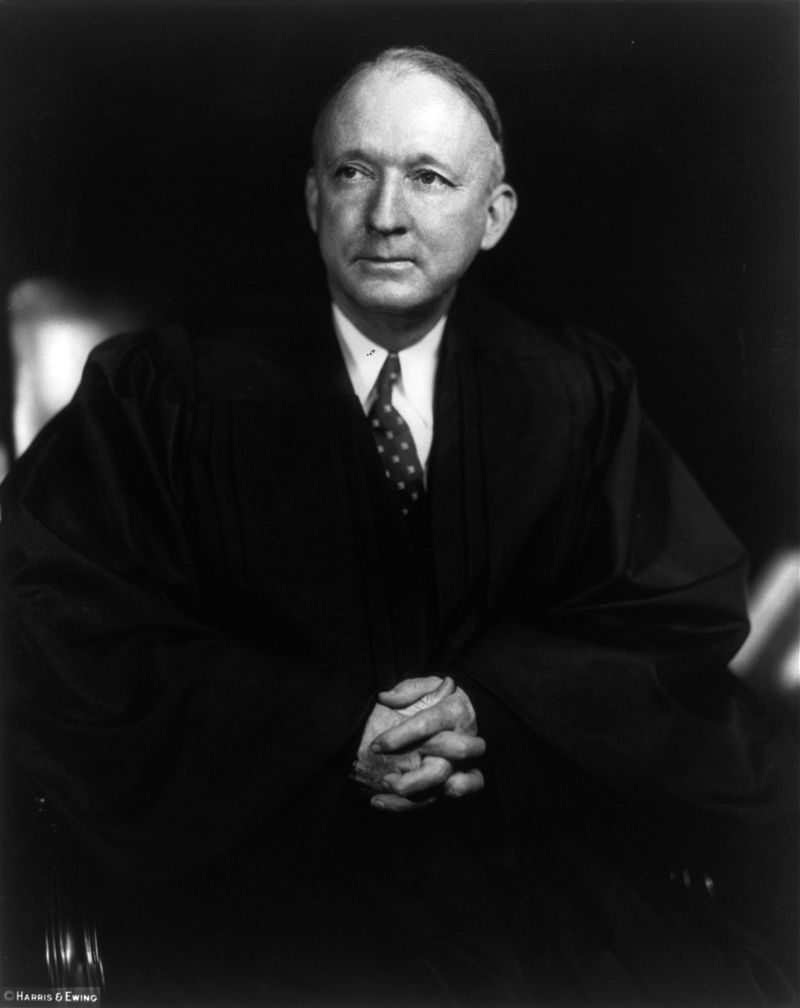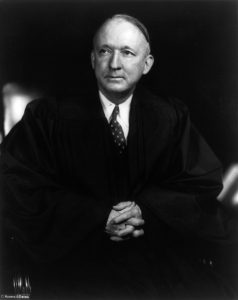A look back at Justice Hugo Black’s first day on the bench

Protesters repeatedly interrupted Justice Brett Kavanaugh’s confirmation hearing in September, but the new justice’s first day on the bench this morning passed without disruption.
At least one justice had a more eventful inaugural experience.
On October 4, 1937, Justice Hugo Black’s first day, “two vigorous protests to his legal right to sit were laid before the other justices and himself,” as reported in the New York Times. In contrast to disruptions to Supreme Court proceedings in 2015 – in which protesters were removed and warned by Chief Justice John Roberts of criminal charges — Chief Justice Charles Evans Hughes engaged with both men, who tried to make verbal legal arguments, were allowed to remain in the courtroom, and spoke afterward with reporters.
Patrick Henry Kelly, a lawyer, first approached the bench and introduced himself after Hughes welcomed Black and asked if there were any bar admissions.
Hughes quickly cut him off, asking, “Are you here to present a candidate for admission to the bar?”
When Kelly said he wasn’t, Hughes called him “out of order,” and an attendant escorted him to his seat.
Kelly interrupted again shortly thereafter, announcing “a question of personal privilege.” This time Hughes asked him, “Is it in writing?”
“I put it in writing in a letter to each of the justices,” Kelly answered.
“If it is in writing, it will be considered,” Hughes replied.
This is when Albert Levitt – a former U.S. assistant attorney general, elaborately identified in the Times as a “soldier of fortune, preacher, professor, corporation lawyer, Federal judge and utility ‘baiter'” – rose to speak. He said he wanted to file a brief asking the court to order Black to show cause for being permitted to serve as a justice. Hughes told Levitt to submit the brief to the clerk of the court.
Kelly then made his third announcement, holding a piece of paper he claimed was his motion.
“Very well, you may submit it to the clerk; it will be considered by the Court,” Hughes said.
Throughout these exchanges, “Mr. Black the new justice sat back in his big leather chair. His lips were set tightly together and his hands clasped over the rich black silk robe which he wore for the first time.”
Kelly and Levitt’s written arguments involved the clause of the Constitution that states: “No Senator or Representative shall, during the Time for which he was elected, be appointed to any civil Office under the Authority of the United States, which shall have been created, or the Emoluments whereof shall have been increased during such time.”
As explained by Todd B. Tatelman in a 2009 report by the Congressional Research Service, “The Emoluments Clause: History, Law, and Precedents,” Black had been a senator when Congress raised the pension amount for justices retiring over age 70.
Justice Willis Van Devanter, over 70 and among the “Four Horsemen” whose rulings striking down New Deal legislation contributed to President Franklin Roosevelt’s court-packing plan, soon retired.
Opponents to Black argued that the nominee, who had been elected to serve as a senator until March 4, 1939, could not in 1937 constitutionally serve as a justice after Congress had so recently increased the justices’ pensions.
His supporters argued that Black, then only 51, would not receive any pension benefits until long after his senatorial term would have expired.
According to Tatelman, the Supreme Court ultimately disposed of Levitt’s case, Ex parte Levitt, in a per curiam opinion “stating that the plaintiffs’ interest was insufficient as all they could demonstrate was that they were citizens and members of the Supreme Court bar.”
Black’s nomination had been contentious from the beginning. Turner Catledge reported for the New York Times on August 13, the day after Roosevelt picked Black, that the nomination “dropped like salt into the political wounds already rubbed raw by the court issue” and other conflicts.
Two senators insisted that Black’s nomination be referred to the Senate Judiciary Committee. Catledge wrote that the “Senate’s rule of courtesy by which executive appointees from its membership are confirmed promptly and unanimously was thus abrogated for the first time since L.Q.C. Lamar of Mississippi was nominated to the court in 1888.” (Lamar was nominated on December 6, 1887 and confirmed on January 16, 1888.)
Nevertheless, Black was confirmed by a 63-16 vote only days later, on August 17, 1937.
As Virginia Van Der Veer detailed in an 1968 issue of American Heritage, rumors about Black’s past membership in the Ku Klux Klan had circulated after his nomination, but only in September did a series of articles by Ray Sprigle of the Pittsburgh Post-Gazette present evidence that broke open the story.
On October 1, Black went on national radio to give an 11-minute speech in which he admitted to having once joined the Klan but condemned the “concerted campaign” against him. Van Der Veer wrote that “newspapers opposed to the President almost universally criticized the speech,” but Roosevelt called the speech “a grand job [that] did the trick” for convincing “the man in the street.”
Three days later, Black took the bench. Upon Black’s retirement in September 1971, after 34 years as a justice, Robert Semple in the New York Times described Black as having been “firmly within the ‘liberal’ wing of the Court, particularly on cases involving freedom of expression and religion,” and as having “joined the majority in the landmark cases of the 1950’s and 1960’s in which the Court broadened racial desegregation in the schools and in public accommodations.”
Posted in Supreme Court history

